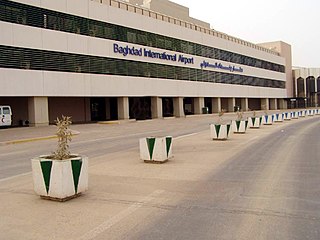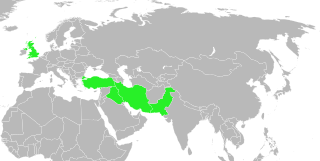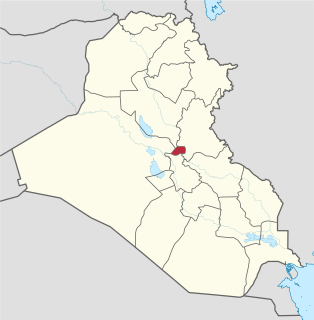Hussein Al-Tahan (born 1955 in Baghdad) was the governor of Baghdad in Iraq from 2005 to 2009.
Hussein Al-Tahan (born 1955 in Baghdad) was the governor of Baghdad in Iraq from 2005 to 2009.

Baghdad is the capital of Iraq and the second-largest city in the Arab world after Cairo. It is located on the Tigris near the ruins of the ancient Akkadian city of Babylon and the Sassanid Persian capital of Ctesiphon. In 762 CE, Baghdad was chosen as the capital of the Abbasid Caliphate, and became its most notable major development project. Within a short time, the city evolved into a significant cultural, commercial, and intellectual center of the Muslim world. This, in addition to housing several key academic institutions, including the House of Wisdom, as well as a multiethnic and multi-religious environment, garnered it a worldwide reputation as the "Center of Learning".

The Abbasid Caliphate was the third caliphate to succeed the Islamic prophet Muhammad. It was founded by a dynasty descended from the prophet's uncle, Abbas ibn Abdul-Muttalib, from whom the dynasty takes its name. They ruled as caliphs for most of the caliphate from their capital in Baghdad in modern-day Iraq, after having overthrown the Umayyad Caliphate in the Abbasid Revolution of 750 CE (132 AH). The Abbasid Caliphate first centered its government in Kufa, modern-day Iraq, but in 762 the caliph Al-Mansur founded the city of Baghdad, near the ancient Babylonian capital city of Babylon. Baghdad became the center of science, culture and invention in what became known as the Golden Age of Islam. This, in addition to housing several key academic institutions, including the House of Wisdom, as well as a multiethnic and multi-religious environment, garnered it a worldwide reputation as the "Center of Learning".

Baghdad International Airport, previously Saddam International Airport is Iraq's largest international airport, located in a suburb about 16 km (9.9 mi) west of downtown Baghdad in the Baghdad Governorate. It is the home base for Iraq's national airline, Iraqi Airways.

The Middle East Treaty Organization (METO), also known as the Baghdad Pact and subsequently known as the Central Treaty Organization (CENTO), was a military alliance of the Cold War. It was formed in 24 February 1955 by Iran, Iraq, Pakistan, Turkey, and the United Kingdom. The alliance was dissolved in 16 March 1979.

Baghdad Governorate, also known as the Baghdad Province, is the capital governorate of Iraq. It includes the capital Baghdad as well as the surrounding metropolitan area. The governorate is one of two small provinces of all 19 in Iraq into which the country divides entirely, yet by a margin of almost three-to-one, the most populous.

The Battle of Baghdad, also known as the Fall of Baghdad, was a military invasion of Baghdad that took place in early April 2003, as part of the invasion of Iraq.

Al-Kāẓimiyyah or Al-Kāẓimayn (ٱلْكَاظِمَيْن) is a northern neighbourhood of the city of Baghdad, Iraq. It is about 5 kilometres (3.1 mi) from the city's center, on the west bank of the Tigris. Al-Kāẓimiyyah is also the name of one of nine administrative districts in Baghdad. Being the place of Al-Kadhimiya Mosque, even before its inception into the urban area of Baghdad, it is regarded as a holy city by Twelver Shia.

The Fall of Baghdad occurred during the Mesopotamia Campaign, fought between the forces of the British Empire and the Ottoman Empire in the First World War.

The siege of Baghdad was a siege that took place in Baghdad in 1258, lasting for 13 days from January 29, 1258 until February 10, 1258. The siege, laid by Ilkhanate Mongol forces and allied troops, involved the investment, capture, and sack of Baghdad, which was the capital of the Abbasid Caliphate at that time. The Mongols were under the command of Hulagu Khan, brother of the khagan Möngke Khan, who had intended to further extend his rule into Mesopotamia but not to directly overthrow the Caliphate. Möngke, however, had instructed Hulagu to attack Baghdad if the Caliph Al-Musta'sim refused Mongol demands for his continued submission to the khagan and the payment of tribute in the form of military support for Mongol forces in Persia.

The 2006 Sadr City bombings were a series of car bombs and mortar attacks in Iraq that occurred on 23 November at 15:10 Baghdad time and ended at 15:55. Six car bombs and two mortar rounds were used in the attack on the Shia slum in Sadr City.
The 27 October 2003 Baghdad bombings were a series of suicide car bombings targeting the Red Cross headquarters and four Iraqi police stations in Baghdad. The attacks killed 34 people and injured another 224.
The 18 April 2007 Baghdad bombings were a series of attacks that occurred when five car bombs exploded across Baghdad, the capital city of Iraq, on 18 April 2007, killing nearly 200 people.
The 2 November 2010 Baghdad attacks were a series of bomb attacks in Baghdad, Iraq that killed more than 110 people.
The 2015 Baghdad market truck bombing was a truck bomb attack on 13 August 2015, targeting a Baghdad food market in Sadr City, a predominantly Shi'ite neighborhood.
The February 2016 Baghdad bombings occurred on 28 February 2016. At least 70 people were killed and 60 wounded in Sadr City, a southern suburb of Baghdad, as two bombs went off at a crowded market. The explosions ripped through a market selling mobile phones in the mainly Shiite Muslim district. The assailants were suicide bombers riding motorcycles through the crowd.
On 11 May 2016, the Islamic State conducted a series of attacks in and near Baghdad, the capital of Iraq, killing at least 110 people and wounding more than 165. According to ISIL, attacks were aimed at Shia fighters.
On 17 May 2016, a series of bombings by the terrorist group Islamic State of Iraq and the Levant hit the Iraqi capital city of Baghdad. At least 101 people were killed and 194 injured.

On 3 July 2016, ISIL militants carried out coordinated bomb attacks in Baghdad that killed 340 civilians and injured hundreds more. A few minutes after midnight local time, a suicide truck-bomb targeted the mainly Shia district of Karrada, busy with late night shoppers for Ramadan. A second roadside bomb was detonated in the suburb of Sha'ab, killing at least five.

The January2021 Baghdad bombings were a pair of terrorist attacks that occurred on 21 January 2021, carried out by two suicide bombers at an open-air market in central Baghdad, Iraq. They killed at least 32 people and injured another 110. This was the Iraqi capital’s first terrorist attack since 2019.